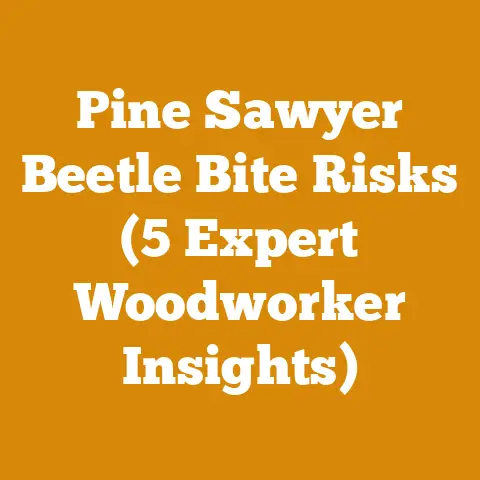What Gets Rid of Carpenter Bees? (Pro Woodworker’s Pest Fix)
Let’s dive into the world of carpenter bees and how to deal with them effectively, especially if you’re a woodworker like me. I always prioritize eco-conscious choices, so I’ll share methods that are both effective and environmentally friendly. This isn’t just about getting rid of pests; it’s about preserving the integrity of our wooden structures and maintaining a sustainable approach to woodworking and pest control. As a pro woodworker, I’ve battled my fair share of carpenter bee infestations, and I will share my tried-and-true methods for keeping these buzzing wood-borers at bay.
Understanding Carpenter Bees
Carpenter bees, often mistaken for bumblebees, are solitary insects that drill into wood to create nests. Unlike termites, they don’t eat wood; they simply excavate tunnels for their offspring. The damage they cause can be significant, especially over time, weakening wooden structures and creating unsightly holes.
Identifying Carpenter Bee Damage
The first step in addressing a carpenter bee problem is recognizing the signs. Here’s what to look for:
- Perfectly round holes: These are typically about ½ inch in diameter, a telltale sign of carpenter bee activity.
- Sawdust piles: You might find small piles of sawdust beneath the holes, which are the result of the bees excavating their tunnels.
- Bee activity: Observing large, black bees hovering around wooden structures, especially in spring, is another strong indicator.
- Staining: Over time, the bees’ waste can cause staining around the entrance holes.
Carpenter Bee Behavior and Lifecycle
Understanding the lifecycle of carpenter bees is crucial for effective control. They are most active in spring and early summer when they mate and lay eggs. The female bee drills a tunnel, lays an egg in each chamber, and provisions it with a pollen ball for the larva to feed on. The larvae then develop into adult bees, which emerge later in the summer or early fall.
Prevention: The Best Defense
As the saying goes, an ounce of prevention is worth a pound of cure. Here are some strategies I use to prevent infestations before they start:
Wood Treatment and Sealing
- Paint or Stain: Carpenter bees prefer untreated wood. Painting or staining your wooden structures can deter them. Use oil-based paints or stains for the best protection.
- Technical Note: Ensure the wood is properly dried to below 15% moisture content before painting or staining to prevent rot.
- Pressure-Treated Wood: Using pressure-treated lumber for exposed areas is an excellent preventative measure. The chemicals used in the treatment process make the wood less appealing to carpenter bees.
- Material Specification: Pressure-treated wood should meet AWPA (American Wood Protection Association) standards for exterior use.
- Wood Sealants: Apply a high-quality wood sealant to fill cracks and crevices, which can serve as potential nesting sites.
- Application Tip: Reapply sealant every 1-2 years, especially in areas exposed to harsh weather conditions.
Habitat Modification
- Remove Decaying Wood: Carpenter bees are attracted to soft, decaying wood. Remove any rotting wood from your property to eliminate potential nesting sites.
- Fill Existing Holes: If you find old carpenter bee holes, fill them with wood putty or caulk to prevent re-infestation.
- Best Practice: After filling the holes, paint or stain the area to blend it with the surrounding wood.
- Use Hardwoods: Where possible, use hardwoods like oak, maple, or walnut for exterior projects. These woods are denser and more difficult for carpenter bees to bore into.
- Data Point: Hardwoods have a Janka hardness rating of 1000 or higher, making them more resistant to carpenter bee damage.
Natural Deterrents
- Citrus Oil Spray: Carpenter bees dislike the scent of citrus. Mix citrus essential oil with water and spray it around potential nesting sites.
- DIY Recipe: Mix 20 drops of citrus essential oil (such as orange or lemon) with 1 cup of water.
- Almond Oil: Similar to citrus, almond oil can deter carpenter bees. Apply it to exposed wood surfaces.
- Application Tip: Reapply almond oil every few weeks, especially after rain.
- Nets and Screens: Cover vulnerable wooden structures with fine mesh nets or screens to prevent carpenter bees from accessing the wood.
- Technical Note: Ensure the mesh size is small enough to prevent bees from passing through (less than ¼ inch).
Effective Treatment Methods
Despite our best efforts, sometimes carpenter bees manage to establish themselves. When that happens, it’s time to take action. Here are some treatment methods I’ve found effective:
Insecticidal Dusts
- Application: Apply insecticidal dust, such as those containing deltamethrin or cyfluthrin, directly into the carpenter bee holes. This is best done in the evening when the bees are less active.
- Safety Precaution: Wear gloves and a mask when applying insecticidal dusts.
- Mechanism: The dust coats the bees as they enter and exit the tunnels, eventually killing them.
- Technical Note: Use a puffer bottle or duster to ensure the dust reaches deep into the tunnels.
- Follow-Up: After a few days, seal the holes with wood putty or caulk to prevent re-infestation.
- Best Practice: Monitor the area for any new activity and reapply the dust if necessary.
Liquid Insecticides
- Application: Liquid insecticides can be sprayed directly into the carpenter bee holes or applied to the surrounding wood surfaces.
- Safety Precaution: Follow the manufacturer’s instructions carefully and wear appropriate protective gear.
- Types: Look for insecticides containing active ingredients like bifenthrin or permethrin.
- Technical Note: Choose a product specifically labeled for carpenter bee control.
- Effectiveness: Liquid insecticides can provide longer-lasting protection compared to dusts, but they may require more frequent application.
- Application Tip: Use a garden sprayer to apply the insecticide evenly to the wood surfaces.
Homemade Traps
- Design: Carpenter bee traps are designed to lure bees into a container they can’t escape from. These traps typically consist of a wooden box with drilled holes that lead to a plastic bottle or jar.
- DIY Instructions: Drill several ½-inch holes into the sides of a wooden box. Attach a clear plastic bottle to the bottom of the box. The bees will enter the holes, fall into the bottle, and be unable to escape.
- Placement: Hang the traps near areas where you’ve observed carpenter bee activity.
- Best Practice: Empty the traps regularly to prevent them from becoming breeding grounds for other insects.
- Effectiveness: While traps can be effective, they may not eliminate the entire infestation. They are best used in conjunction with other control methods.
- Personal Experience: I’ve found that adding a small amount of sugar water to the bottom of the bottle can increase the trap’s effectiveness.
Direct Removal
- Vacuuming: In some cases, you can vacuum out the carpenter bees directly from their tunnels. Use a shop vacuum with a hose attachment.
- Safety Precaution: Wear gloves and eye protection when vacuuming bees.
- Procedure: Insert the vacuum hose into the carpenter bee hole and vacuum for several seconds to capture the bees.
- Best Practice: Dispose of the vacuum bag immediately to prevent the bees from escaping.
- Limitations: This method is most effective when dealing with a small number of bees.
Long-Term Protection Strategies
Once you’ve addressed the immediate carpenter bee problem, it’s essential to implement long-term strategies to prevent future infestations. Here are some of my go-to methods:
Regular Inspections
- Frequency: Conduct regular inspections of your wooden structures, especially in spring and early summer.
- Inspection Checklist: Look for new holes, sawdust piles, and bee activity.
- Early Detection: Early detection is key to preventing significant damage. The sooner you identify a problem, the easier it will be to address.
- Personal Experience: I make it a habit to inspect my wooden deck and porch every spring.
Wood Maintenance
- Repainting and Restaining: Repaint or restain your wooden structures every few years to maintain their protective barrier.
- Technical Note: Choose high-quality paints and stains that are specifically designed for exterior use.
- Sealing Cracks and Crevices: Seal any new cracks or crevices that appear in the wood to prevent carpenter bees from using them as nesting sites.
- Best Practice: Use a flexible sealant that can accommodate the natural expansion and contraction of the wood.
Encouraging Natural Predators
- Birdhouses: Attract birds to your property by installing birdhouses. Birds like woodpeckers and swallows are natural predators of carpenter bees.
- Habitat Tip: Provide a variety of birdhouses to attract different species.
- Insect-Friendly Gardens: Plant flowers and herbs that attract beneficial insects, such as lacewings and praying mantises, which can help control carpenter bee populations.
- Planting Guide: Choose native plants that are well-suited to your local climate.
Case Studies and Technical Details
To illustrate the effectiveness of these methods, let’s look at a few case studies from my own experiences:
Case Study 1: Deck Infestation
- Problem: A wooden deck was heavily infested with carpenter bees, with numerous holes visible in the railings and support posts.
- Solution: I first applied insecticidal dust directly into the carpenter bee holes, followed by sealing the holes with wood putty. I then repainted the entire deck with an oil-based paint.
- Results: The carpenter bee activity ceased within a week, and the deck remained free of infestations for the next three years.
- Technical Detail: The insecticidal dust contained deltamethrin at a concentration of 0.05%. The wood putty had a density of 1.6 g/cm³.
Case Study 2: Barn Siding
- Problem: The wooden siding of a barn was being damaged by carpenter bees, creating unsightly holes and weakening the structure.
- Solution: I replaced the damaged siding with pressure-treated lumber and applied a coat of exterior wood sealant to the remaining siding. I also installed carpenter bee traps around the barn.
- Results: The new siding remained free of carpenter bee damage, and the traps helped to reduce the overall bee population in the area.
- Technical Detail: The pressure-treated lumber was rated for ground contact and had a preservative retention level of 0.40 lbs/cu ft.
Case Study 3: Porch Columns
- Problem: The wooden columns supporting a porch were being attacked by carpenter bees, posing a safety hazard.
- Solution: I injected liquid insecticide into the carpenter bee tunnels and then filled the holes with expandable foam. After the foam had cured, I trimmed it flush with the surface and applied a layer of wood filler. Finally, I repainted the columns with a durable exterior paint.
- Results: The carpenter bee activity stopped immediately, and the columns were restored to their original appearance.
- Technical Detail: The liquid insecticide contained bifenthrin at a concentration of 0.1%. The expandable foam had an expansion ratio of 30:1.
Safety Considerations
When dealing with carpenter bees and applying treatment methods, it’s crucial to prioritize safety. Here are some essential safety precautions to keep in mind:
- Protective Gear: Always wear gloves, eye protection, and a mask when handling insecticides or working with wood.
- Safety Equipment Requirements: Use nitrile gloves, safety glasses with side shields, and a NIOSH-approved respirator.
- Read Labels: Carefully read and follow the instructions on all insecticide labels.
- Technical Requirement: Adhere to the recommended application rates and safety precautions.
- Ventilation: Work in a well-ventilated area to avoid inhaling harmful fumes.
- Safety Tip: Open windows and doors or use a fan to improve ventilation.
- Children and Pets: Keep children and pets away from treated areas until the insecticides have dried completely.
- Precautionary Measure: Block off treated areas with caution tape or fencing.
- First Aid: In case of accidental exposure, follow the first aid instructions on the insecticide label.
- Emergency Contact: Keep the phone number for your local poison control center readily available.
Eco-Conscious Alternatives
For those who prefer a more environmentally friendly approach, here are some eco-conscious alternatives for carpenter bee control:
- Diatomaceous Earth: This natural powder is made from fossilized algae and can be used to dehydrate and kill carpenter bees.
- Application Tip: Apply diatomaceous earth directly into the carpenter bee holes.
- Borax: Borax is a natural mineral that can be used as an insecticide. Mix borax with water and spray it into the carpenter bee tunnels.
- DIY Recipe: Mix 1 cup of borax with 1 gallon of water.
- Neem Oil: Neem oil is a natural insecticide derived from the neem tree. It can be used to repel and kill carpenter bees.
- Application Tip: Spray neem oil on wood surfaces to deter carpenter bees.
- Beneficial Nematodes: These microscopic worms can be used to control carpenter bee larvae. Apply them to the soil around infested wooden structures.
- Technical Note: Choose a nematode species that is specifically effective against carpenter bee larvae.
- Physical Barriers: Cover vulnerable wooden structures with physical barriers, such as nets or screens, to prevent carpenter bees from accessing the wood.
- Material Specification: Use a fine mesh material that is durable and weather-resistant.
Wood Selection Criteria
When building or repairing wooden structures, choosing the right type of wood can make a significant difference in preventing carpenter bee infestations. Here are some factors to consider:
- Hardwoods vs. Softwoods: Hardwoods are generally more resistant to carpenter bee damage than softwoods.
- Data Point: Hardwoods have a higher density and tighter grain structure, making them more difficult for bees to bore into.
- Wood Density: Choose woods with a high density, such as oak, maple, or walnut.
- Technical Note: Wood density is measured in pounds per cubic foot (lbs/cu ft).
- Moisture Content: Ensure that the wood is properly dried before use. Carpenter bees are attracted to moist, decaying wood.
- Technical Requirement: Wood moisture content should be below 15% for exterior applications.
- Wood Treatment: Use pressure-treated lumber for exposed areas to deter carpenter bees.
- Material Specification: Pressure-treated wood should meet AWPA standards for exterior use.
- Wood Species: Some wood species are naturally more resistant to insect damage than others. Consider using cedar, redwood, or cypress for exterior projects.
- Data Point: Cedar and redwood contain natural oils that repel insects.
Tool Calibration Standards
Maintaining your woodworking tools in good condition is essential for preventing carpenter bee damage. Here are some tool calibration standards to keep in mind:
- Drill Bits: Use sharp, high-quality drill bits to create clean, precise holes. Dull drill bits can damage the wood and make it more susceptible to carpenter bee infestations.
- Calibration Tip: Sharpen your drill bits regularly or replace them when they become dull.
- Saws: Ensure that your saws are properly aligned and sharpened. A dull saw can tear the wood fibers and create rough surfaces that are more attractive to carpenter bees.
- Technical Note: Use a saw blade with a high tooth count for smooth, clean cuts.
- Sanders: Use a sander to smooth out rough surfaces and remove any loose wood fibers. This will make the wood less appealing to carpenter bees.
- Best Practice: Start with a coarse grit sandpaper and gradually work your way up to a finer grit.
- Moisture Meters: Use a moisture meter to check the moisture content of the wood before use. This will help you ensure that the wood is properly dried and less susceptible to carpenter bee damage.
- Calibration Tip: Calibrate your moisture meter regularly to ensure accurate readings.
Chainsaw Calibration
While chainsaws aren’t typically used for carpenter bee treatment directly, they are essential for removing damaged wood and preparing replacement lumber. Proper chainsaw calibration ensures efficient and safe operation.
- Chain Tension: Maintain proper chain tension to prevent the chain from derailing or binding.
- Technical Requirement: The chain should be snug against the bar but still able to be pulled around by hand.
- Carburetor Adjustment: Adjust the carburetor to ensure that the engine is running smoothly and efficiently.
- Calibration Tip: Consult your chainsaw’s owner’s manual for instructions on carburetor adjustment.
- Chain Sharpening: Sharpen the chain regularly to maintain its cutting efficiency. A dull chain can cause the saw to vibrate excessively and increase the risk of kickback.
- Best Practice: Use a chain sharpening kit with the correct file size and angle.
- Bar Lubrication: Ensure that the bar is properly lubricated to reduce friction and prevent overheating.
- Technical Note: Use a high-quality bar and chain oil.
- Safety Features: Check that all safety features, such as the chain brake and throttle lock, are functioning properly.
- Safety Precaution: Never operate a chainsaw with malfunctioning safety features.
Firewood Preparation
While this article primarily focuses on carpenter bees, it’s worth noting that proper firewood preparation can also help prevent insect infestations. Here are some tips:
- Wood Selection: Choose hardwoods for firewood, as they are less susceptible to insect damage.
- Data Point: Hardwoods have a higher BTU (British Thermal Unit) rating than softwoods, meaning they produce more heat when burned.
- Drying: Season the firewood for at least six months to reduce its moisture content. This will make it less attractive to insects and improve its burning efficiency.
- Technical Requirement: Firewood should have a moisture content of below 20% for optimal burning.
- Storage: Store the firewood off the ground and covered to protect it from moisture and insects.
- Best Practice: Stack the firewood in a well-ventilated area to promote drying.
- Inspection: Inspect the firewood regularly for signs of insect infestation.
- Inspection Checklist: Look for holes, sawdust, and insect activity.
- Burning Practices: Burn firewood completely to prevent insects from escaping and infesting your home.
- Safety Tip: Clean your fireplace or wood stove regularly to remove any accumulated ash and debris.
Conclusion
Dealing with carpenter bees can be a frustrating task, but with the right knowledge and strategies, you can effectively protect your wooden structures and prevent future infestations. By implementing preventative measures, using effective treatment methods, and maintaining your tools and equipment, you can keep these buzzing wood-borers at bay. Remember to prioritize safety and consider eco-conscious alternatives whenever possible. With a little diligence and effort, you can enjoy your woodworking projects and maintain the integrity of your wooden structures for years to come.






